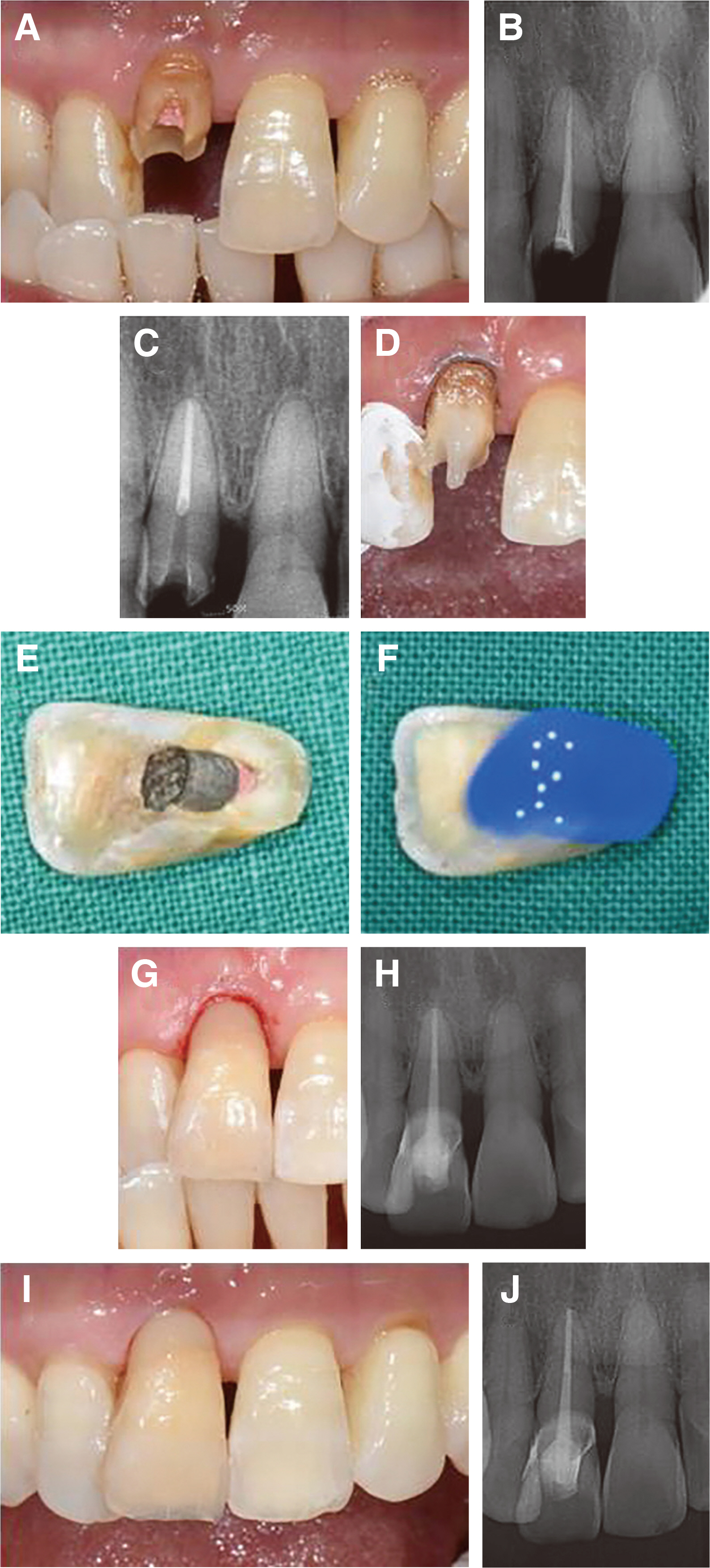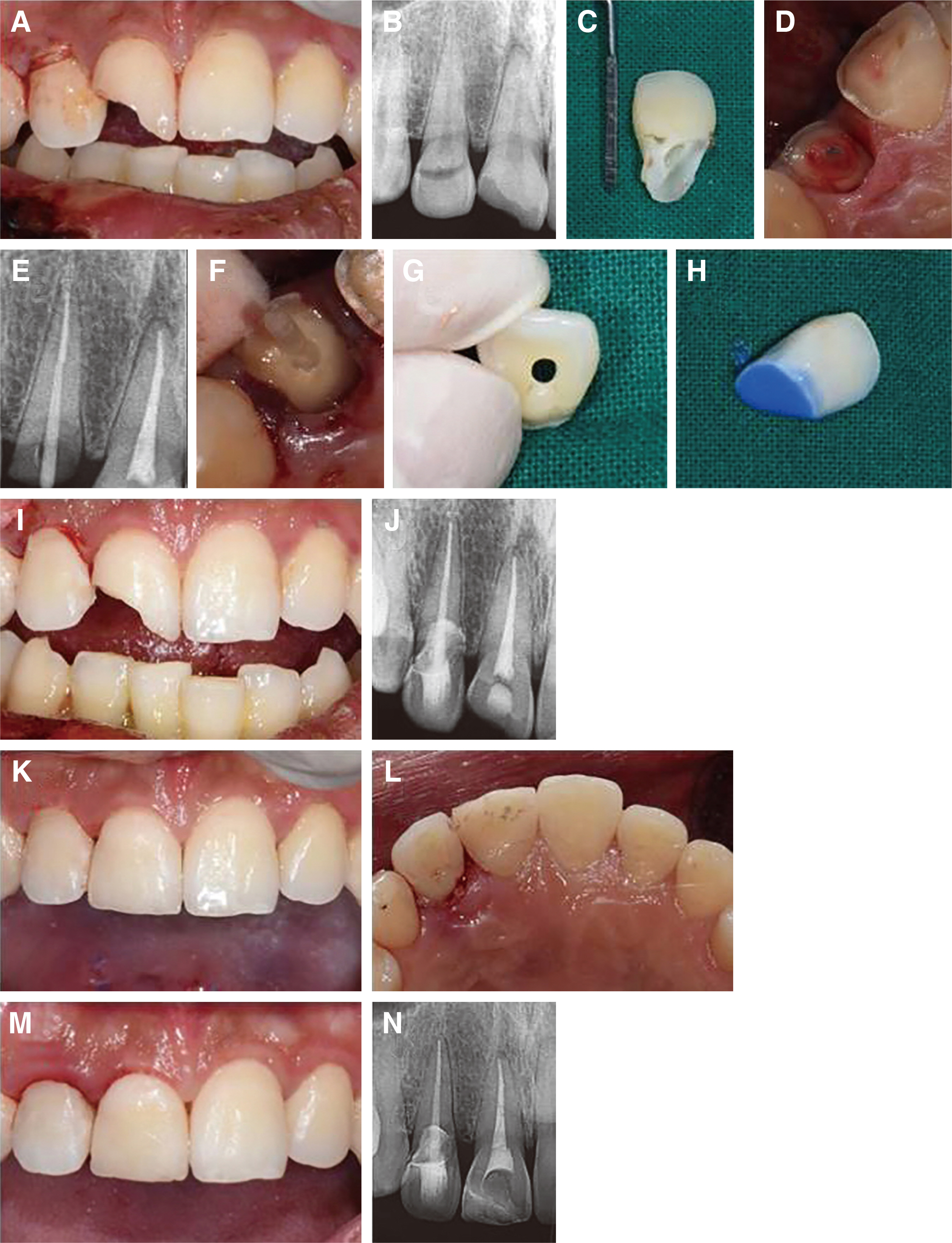J Dent Rehabil Appl Sci.
2021 Dec;37(4):251-258. 10.14368/jdras.2021.37.4.251.
Management of complicated crown fracture by tooth fragment reattachment with fiber post: a case report
- Affiliations
-
- 1Department of Conservative Dentistry, Dental Research Institute, Dental and Life Science Institute, School of Dentistry, Pusan University, Yangsan, Republic of Korea
- 2Dental Clinic Center, Pusan National University Hospital, Busan, Republic of Korea
- KMID: 2526000
- DOI: http://doi.org/10.14368/jdras.2021.37.4.251
Abstract
- Dental trauma is very common in children and relatively young people, with the line of treatment depending on the time elapsed, age of the child, and tooth maturity. If the fractured segment is available and there is close approximation of the segment to the remaining tooth, reattachment of the fractured segment is a feasible option. This treatment offers several advantages, including the reestablishment of function, aesthetics, shape, shine and surface texture, in addition to the original contour and alignment of the teeth. The following cases present two different complex crown fracture cases that were treated using tooth fragment reattachment with fiber-reinforced composite post.
Figure
Reference
-
References
1. Ameur MS, Kallel I, Chtioui F, Douki N. 2021; Tooth Fragment Reattachment with Glass Fiber Reinforced Post: A Case Report. J Pediatr Dent. 7:00–00. DOI: 10.14744/JPD.2021.02_28.2. Akyuz SN, Erdemir A. 2012; Restoration of tooth fractures using fiber post and fragment reattachment: Three case reports. Eur J Gen Dent. 1:94–8. DOI: 10.4103/2278-9626.103393.3. Jyothi M, Jyothirmayi BSL, Sirisha K, Mounika A, Girish K, uthi Keerthi MH Sr. 2016; Reattachment-Conservative management of complicated crown fractures in anterior teeth. Int J Appl Dent Sci. 2:10–3.4. Maitin N, Maitin SN, Rastogi K, Bhushan R. 2013; Fracture tooth fragment reattachment. BMJ Case Rep. 2013:bcr2013009183. DOI: 10.1136/bcr-2013-009183. PMID: 23853012. PMCID: PMC3736189.5. Olsburgh S, Jacoby T, Krejci I. 2002; Crown fractures in the permanent dentition: pulpal and restorative considerations. Dent Traumatol. 18:103–15. DOI: 10.1034/j.1600-9657.2002.00004.x. PMID: 12110103.6. Aggarwal V, Logani A, Shah N. 2009; Complicated crown fractures-management and treatment options. Int Endod J. 42:740–53. DOI: 10.1111/j.1365-2591.2009.01588.x. PMID: 19548932.7. Hegde SG, Tawani GS, Warhadpande MM. 2014; Use of quartz fiber post for reattachment of complex crown root fractures: A 4-year follow-up. J Conserv Dent. 17:389–92. DOI: 10.4103/0972-0707.136519. PMID: 25125857. PMCID: PMC4127703.8. Bonchev A, Radeva E, Tsvetanova N. 2017; Fiber Reinforced Composite Posts-A Review of Literature. Int J Sci Res. 6:1887–93.9. Quintas AF, Dinato JC, Bottino MA. 2000; Aesthetic posts and cores for metal-free restoration of endodontically treated teeth. Pract Periodontics Aesthet Dent. 12:875–84. PMID: 11405025.10. Vichi A, Grandini S, Davidson CL, Ferrari M. 2002; An SEM evaluation of several adhesive systems used for bonding fiber posts under clinical conditions. Dent Mater. 18:495–502. DOI: 10.1016/S0109-5641(01)00065-3. PMID: 12191661.11. Hilton TJ, Summitt JB, Broome J, Ferracane JL. 2013. Summitt's fundamentals of operative dentistry: a contemporary approach. 4th ed. Quintessence Pub Co.;Batavia: p. 567–8.12. Macedo GV, Diaz PI, De O Fernandes CA, Ritter AV. 2008; Reattachment of anterior teeth fragments: A conservative approach. J Esthet Restor Dent. 20:5–18. DOI: 10.1111/j.1708-8240.2008.00142.x. PMID: 18237334.13. Reis A, Francci C, Loguercio AD, Carrilho MR, Rodriques Filho LE. 2001; Re-attachment of anterior fractured teeth: fracture strength using different techniques. Oper Dent. 26:287–94. PMID: 11357572.14. Raut AW, Mantri V, Shambharkar VI, Mishra M. 2018; Management of complicated crown fracture by reattachment using fiber post: Minimal intervention approach. J Nat Sci Biol Med. 9:93–6. DOI: 10.4103/jnsbm.JNSBM_98_17. PMID: 29456401. PMCID: PMC5812083.15. Chazine M, Sedda M, Ounsi HF, Paragliola R, Ferrari M, Grandini S. 2011; Evaluation of the fracture resistance of reattached incisal fragments using different materials and techniques. Dent Traumatol. 27:15–8. DOI: 10.1111/j.1600-9657.2010.00951.x. PMID: 21244624.16. Davis R, Overton JD. 2000; Efficacy of bonded and nonbonded amalgamin the treatment of teeth with incomplete fractures. J Am Dent Assoc. 131:469–78. DOI: 10.14219/jada.archive.2000.0203. PMID: 10770009.17. Santos VR, Lucchesi JA, Cortelli SC, Amaral CM, Feres M, Duarte PM. 2007; Effects of glass ionomer and microfilled composite subgingival restorations on periodontal tissue and subgingival biofilm: a 6-month evaluation. J Periodontol. 78:1522–8. DOI: 10.1902/jop.2007.070032. PMID: 17668971.18. Farik B, Munksgaard EC, Andreasen JO, Kreiborg S. 1999; Drying andrewetting anterior crown fragments prior to bonding. Endod Dent Traumatol. 15:113–6. DOI: 10.1111/j.1600-9657.1999.tb00766.x. PMID: 10530153.19. Jalannavar P, Tavargeri A. 2018; Influence of storage media and durationof fragment in the media on the bond strength of the reattachedtooth fragment. Int J Clin Pediatr Dent. 11:83–8. DOI: 10.5005/jp-journals-10005-1490. PMID: 29991858. PMCID: PMC6034058.20. Poubel DLN, Almeida JCF, Dias Ribeiro AP, Maia GB, Martinez JMG, Garcia FCP. 2017; Effect of dehydration and rehydration intervalson fracture resistance of reattached tooth fragments using a multimode adhesive. Dent Traumatol. 33:451–7. DOI: 10.1111/edt.12344. PMID: 28419716.21. Madhubala A, Tewari N, Mathur VP, Bansal K. 2019; Comparative evaluation of fracture resistance using two rehydration protocols for fragment reattachment in uncomplicated crown fractures. Dent Traumatol. 35:199–203. DOI: 10.1111/edt.12473. PMID: 30933418.22. Bourguignon C, Cohenca N, Lauridsen E, Flores MT, O'Connell AC, Day PF, Tsilingaridis G, Abbott PV, Fouad AF, Hicks L, Andreasen JO, Cehreli ZC, Harlamb S, Kahler B, Oginni A, Semper M, Levin L. 2020; International Association of Dental Traumatology guidelines for the management of traumatic dental injuries: 1. Fractures and luxations. Dent Traumatol. 36:314–30. DOI: 10.1111/edt.12578. PMID: 32475015.23. Sharmin DD, Thomas E. 2013; Evaluation of the effect of storage medium on fragment reattachment. Dent Traumatol. 29:99–102. DOI: 10.1111/j.1600-9657.2012.01143.x. PMID: 22515173.24. Sapna CM, Priya R, eedevi NB Sr, Rajan RR, Kumar R. 2014; Reattachment of fractured tooth fragment with fiber post: A case series with 1-year followup. Case Rep Dent. 2014:376267. DOI: 10.1155/2014/376267. PMID: 25530889. PMCID: PMC4235191.25. Fernandes AS, Dessai GS. 2001; Factors affecting the fracture resistance of post-core reconstructed teeth: a review. Int J Prosthodont. 14:355–63. PMID: 11508092.26. Mobilio N, Borelli B, Sorrentino R, Catapano S. 2013; Effect of fiber post length and bone level on the fracture resistance of endodontically treated teeth. Dent Mater J. 32:816–21. DOI: 10.4012/dmj.2013-069. PMID: 24088839.
- Full Text Links
- Actions
-
Cited
- CITED
-
- Close
- Share
- Similar articles
-
- One-visit Apexification Using MTA and Reattachment of a Crown-root Fractured Tooth with Severe Coronal Damage: A Case Report
- Treatment of crown-root fracture with a modified crown fragment reattachment technique
- Conservative and esthetic approach in crown fracture of maxillay anterior tooth: tooth fragment reattachment
- Reattachment of a fractured fragment with relined fiber post using indirect technique: a case report
- Fracture Resistance of Incisal Tooth Fragment reattached with different Materials and Preparation



